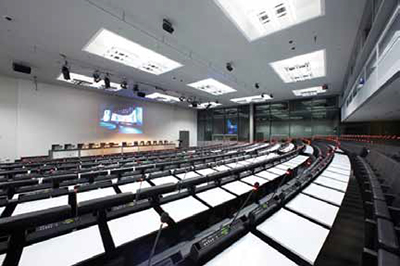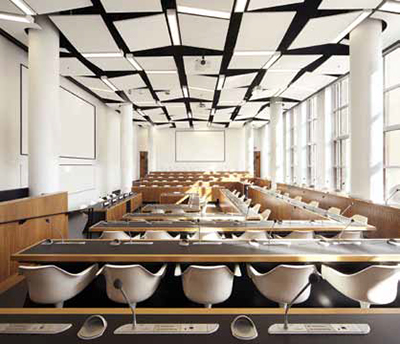The University of Montreal in Quebec lecture hall showcases the Taiden modular flushmounting digital conference system with electronic voting buttons for student polling, as well as language channel selectors to listen to simultaneous interpretation.While global business is far from a new trend, communicating in the multinational economy has taken longer to catch up to corporate needs. Wired and wireless tabletop conferencing systems in today’s multimedia world, by necessity, have taken off quicker in Europe, but they are trickling into the U.S. market where the benefits for businesses are elucidating, and ultimately, systems integrators are poised to reap the benefits.
“Errors in communication with multinational interdepartmental meetings can have catastrophic consequences if ideas and instruction fail to be fully understood,” noted David Dunn, Media Vision’s senior product manager in Canada. “The solution lies in structured, orderly meetings in which participants are recognized and localized, allowing for translation services to be provided to all participants in the appropriate language and subsequently recorded and transcribed for archival and reference purposes.”
The technology has moved to become more inclusive of a wide range of participants, in different locations and communicating in various languages. Media Vision’s Taiden Attend device combines the elements of a static conference with remote capabilities, allowing participants and translators to participate in a single, controlled meeting. “To further extend this level of participation, it is now possible to combine a number of discrete conference spaces and bring them together as one cohesive integrated conference system; this in turn can be expanded outward to a globally integrated, fully multilingual conference,” Dunn said.
Media Vision also offers the Taiden Paperless Multimedia Congress Terminals, available in 15 different models, for tabletop or flush-mounted applications. These devices are capable of speech, vote, and simultaneous interpretation management, as well as speech text guidance, document editing and management, desktop sharing, and multiple channel video on demand, among other features.
The benefits of a conferencing system with modular features and settings include eliminating most of a room’s acoustical challenges, as well as improving intelligibility with individual headsets and volume control, according to Mark Andersen, product marketing manager at Bosch public address and conferencing. “Mixing wired and wireless tabletop systems allows for easy room coupling, audience participation, and multi-session applications,” he continued, “while flush-mount conference microphone systems can help alleviate architectural aesthetic concerns and provide the same functionality as desktop wired systems.”
The latest technology from Bosch focuses on blending multimedia features with conferencing applications, such as sharing a presentation, voting, and managing remote locations wirelessly, which are all simple and secure with the new systems. Recently, Bosch introduced wired and wireless capability on the same controller, Andersen said. “This new system is more secure with three levels of encryption, which virtually eliminates the potential for eavesdropping.”

The expansive Rosengarten Mannheim meeting and event space in Mannheim, Germany accommodates more than 9,000 participants, with conferencing and simultaneous
interpretation from Brahler.The language distribution and interpretation functionality in particular has experienced popularity in Europe “and is now growing in the U.S.,” Andersen surmised, noting, “Schools are also big users of this technology.”
The different language interpretations are transmitted to a pocket receiver, and then to a user’s headphones. Bosch achieves this with infrared digital technology “because of its inherent security, flexibility, and seamless integration with our conference systems.”
As business enterprises continue to secure means for optimizing productivity and efficiency, there is a growing need for collaboration and meeting management, so these trends will “absolutely” be a boon to sales in the U.S. permanent installation market, affirmed Stephen Kohler, Shure’s director of product marketing for the Americas business unit. “We are definitely seeing a trend toward increased global meeting requirements, and conference systems will serve an integral role in that transition,” he said. “Since translation capabilities are part and parcel of these types of conference systems, integrating multiple language capabilities is greatly simplified.”
Shure offers advanced systems like the DIS 6000 series with as many as 30 different languages available to meeting participants, “and even entry-level systems such as the new DIS 5900 series offer at least one or two translation channels,” Kohler said. The software capabilities of these systems allow participants to interact with agenda management, voting, web streaming and archiving of meetings. “These capabilities encompass the overall trend of the ‘paperless meeting’ and are a core focus of the DIS line of solutions.”
Some of the newer features of conferencing systems will emerge from the interfacing of other products and technologies, according to David Astri, managing director of Conference Systems, the exclusive distributor for Brahler in the U.S. He also suggested that biometrics is a new feature that may improve meeting interaction; one example being a fingerprint reader as means for identifying participants.
As advanced, multimedia conferencing systems filter down to U.S. permanent installations, heightened interactivity and communication features matched with ease of use are set to fortify these systems in the domestic market.
“Increasing needs for multimedia use, flexibility with meeting location and size, security, and intelligibility are creating growth opportunities for dealers in the conferencing market,” Andersen said.
The technology will continue to evolve, possibly even matching certain consumer trends. “As users become more comfortable with their tablet computers, they will look for similar touchscreen access and capability in their conferencing systems,” Bosch’s Andersen suggested. “Dealers and integrators who are comfortable integrating these systems will find a market growing faster than the traditional conferencing space.”
Products will continue on current evolution paths, where they will find their ways downstream in the market, Brahler’s Astri predicted. “The products and technology used by the one percent of the market will find their way down market to more end users.”
Shure’s Kohler also expects to see increased implementation of conference systems in the U.S., based on the strength of their capabilities, which will advance with software and digital networking control, as well as webbased and wireless functions.
While business trends in the U.S. are sure to heavily impact the adoption of these products, ultimately, the engine driving demand is the global nature of the world economy. As Media Vision’s Dunn summed up, “if the U.S. is to take it’s place as the worlds largest and most successful economy, it must reach out and speak to its partner…in languages they can understand.”
Lindsey Adler is the associate editor of SCN, Residential Systems, and Healthcare AV.

